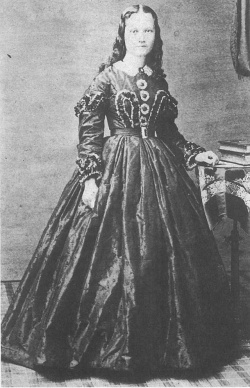Mary E. Foster
ARTICLE UNDER CONSTRUCTION
ARTICLE UNDER CONSTRUCTION
Mrs. Mary E. Foster was a Hawaiian Theosophist who was close to the Buddhist leader Anagarika Dharmapala and was a great benefactor of the Maha Bodhi Society of India.
Early life
Mary Elizabeth Makahala Robinson was born in Honolulu on September 20, 1844. Her parents were John James Robinson, a shipwrecked English sailor, and Rebecca Kaikilani Prever, who was a descendant of the famous Hawaiian king Kamehameha I. Thus, Mary was related to Queen Liliʻuokalani, who was six years older, and was one of the monarch's closest friends. Mark P. Robinson, Mary's brother, served as Queen Lili'uokalani's Minister of Foreign Affairs. [1] It was a difficult time to be royalty in the Islands. During the period 1893-1896, the queen was forcibly and illegally deposed by agents of the American government, and eventually Hawai'i was made a protectorate of the United States.
Mary was educated at the O'ahu Charity School, which taught children of foreign residents married to Hawaiians.
In 1860, Mary Robinson married Thomas R. Foster of Nova Scotia, who founded the Interisland Steam Navigation Company, and owned a shipyard, a shipping agency and a number of schooners. He died in 1889, leaving her a very wealthy widow, as she had also inherited substantial property from her father following his death in 1876.[2]
Theosophical Society involvement
After her husband's death, Mary became interested in Theosophy. She organized lectures and classes, and helped to organize the Aloha Branch in February 1894, with Dr. Auguste Marques as lodge President. They also established several other study groups. Her brother Mark Robinson, a prominent banker and invester, was also involved; he hosted Theosophical gatherings at his home.[3]
Anagarika Dharmapala
Following his remarkable success as a speaker at the World's Parliament of Religions in Chicago, the Anagarika Dharmapala traveled by the steamer S.S. Oceanic via Honolulu, Japan, and Thailand as he returned to Ceylon. "On boarding the S.S. In Honolulu, he met Mrs. Foster. "She approached him wishing to know whether Buddhism could help her to subdue her anger. Practicing the advice given, she found amazing results."[4]
Support of Buddhist causes
Foster Botanical Garden
The garden at Mrs. Foster's residence was planted with indigenous flora and ornamental specimens. She lived at 50 North Vineyard Boulevard, Honolulu for several decades after she and Captain Foster purchased the property in 1884 from a German botanist, who had nurtured the collection of flora for 30 years. Mrs. Foster purchased additional land and consulted with botanists to identify the varieties of plants.[5]
Giant lumbering Galápagos tortoises used to make their way amid the tropical terraced trails, with a niece or nephew of Mrs. Foster on their wide, smooth backs. The tortoises were a gift, like many of the plants, from visiting sea adventurers. When Mary Foster passed away the Galápagos tortoises went to the zoo.[6]
Dharmapala brought Mrs. Foster a cutting from an ancient tree planted in 288 B.C. at the Mahabodhi temple in Anuradhapura, Ceylon, that is a direct descendant of the famous "Bo Tree" under which Gautama Buddha attained enlightenment. From the tree that took root in her garden, several other bo trees were provided to other gardens at Hawaiian Buddhist viharas.[7] At her death in 1930, the property was bequeathed to the city of Honolulu as its first botanical garden.
Later years
At times Mrs. Foster traveled to San Francisco, and she may have also visited South Asia. She spent time in Oahu, as well. In her final year she lived with her younger sister, Victoria Ward, and the sister's three middle-aged daughters, in Honolulu.[8] Mary died on December 20, 1930.
Legacy
Mary Foster is remembered through the Foster Botanical Garden and many institutions named after her. "Mary Foster Day" was proclaimed by the mayor of Honolulu in 2006, and a Facebook account called Discover Mary Foster Day was established. A variety of hibiscus was named "Mary Foster."[9] An author, Pat Masters, has announced that she is writing a biographical novel to be titled In Search of Mary Foster. A prayer service honoring Foster is held every month at the Foster-Robinson Hospital in Colombo.[10]
Notes
- ↑ Frank Karpiel, "Theosophy, Culture, and Politics in Honolulu, 1890-1920," Hawaiian Journal of History 30 (1996), 172. Available at this website.
- ↑ Frank Karpiel, "Theosophy, Culture, and Politics in Honolulu, 1890-1920," Hawaiian Journal of History 30 (1996), 172. Available at this website.
- ↑ Frank Karpiel, "Theosophy, Culture, and Politics in Honolulu, 1890-1920," Hawaiian Journal of History 30 (1996), 172. Available at this website.
- ↑ Ven. Ayya Vimala, "Bodhi Trees Around the World: Hawaii – Foster Botanical Garden," Shin Dharm Net. Available at ShinDharmaNet.com].
- ↑ Nancy Arcayna, "Mysterious Mary Foster," Star Bulletin [Honolulu] (September 22, 2006). Available at this website.
- ↑ Heidi Bornhorst, "Mary Foster Deserving of Celebration in Her Honor," Honolulu Advertiser (September 22, 2006). Available at HonululuAdvertiser.com.
- ↑ Ven. Ayya Vimala, "Bodhi Trees Around the World: Hawaii – Foster Botanical Garden," Shin Dharm Net. Available at ShinDharmaNet.com].
- ↑ U. S. Census, 1930.
- ↑ Heidi Bornhorst, "Mary Foster Deserving of Celebration in Her Honor," Honolulu Advertiser (September 22, 2006). Available at HonululuAdvertiser.com.
- ↑ Nancy Arcayna, "Mysterious Mary Foster," Star Bulletin [Honolulu] (September 22, 2006). Available at this website.
